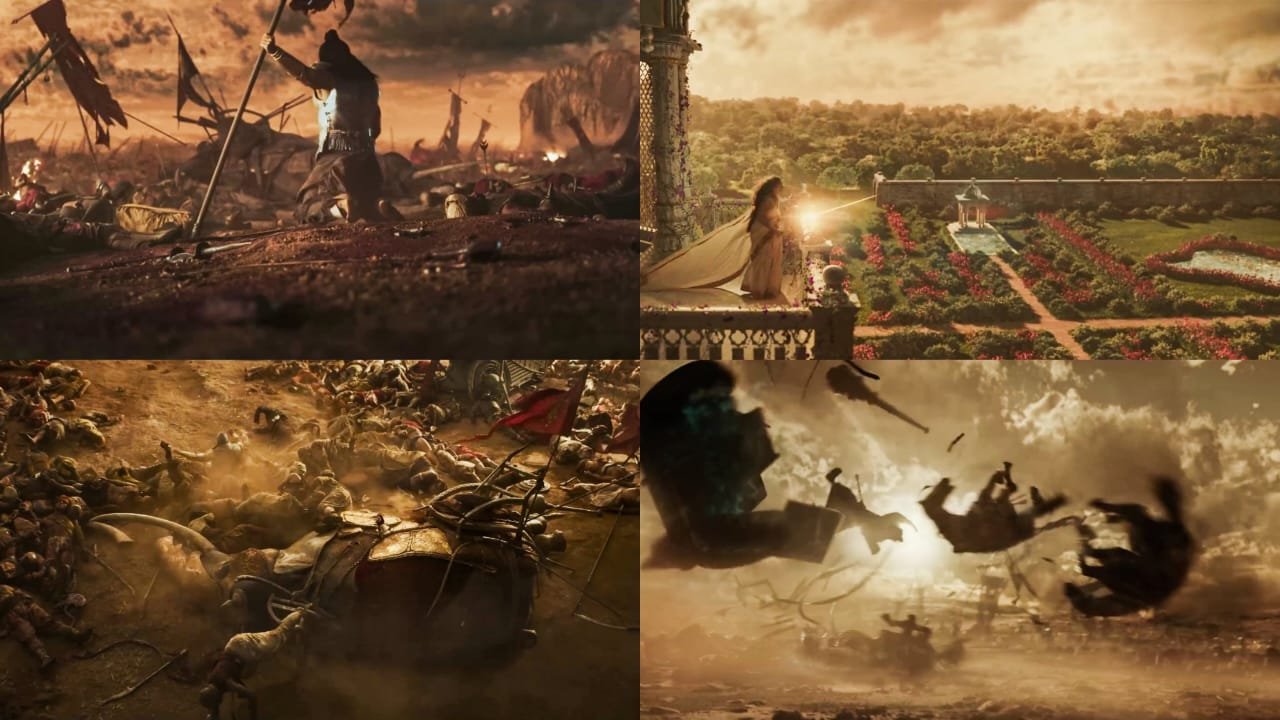Kalki 2898 AD: A Grand Spectacle of Mythological Sci-Fi

Kalki 2898 AD: An Ambitious Intersection of Mythology and Futurism
Nag Ashwin’s Kalki 2898 AD arrived on June 27 amidst a whirlwind of anticipation and excitement. This cinematic venture merges ancient Indian mythology with futuristic dystopian storytelling, offering a unique visual spectacle. Featuring an ensemble cast of Prabhas, Amitabh Bachchan, Deepika Padukone, and Kamal Haasan, the film is set in the year 2898 AD and ventures into a post-apocalyptic world. As it opens with a nod to the aftermath of the Kurukshetra war from the Mahabharata, the stage is set for a futuristic tale that seeks to captivate and challenge its audience.
A Visual and Performance Powerhouse
From the outset, Kalki 2898 AD positions itself as a visual powerhouse. The film’s opening scene, paying homage to the Kurukshetra war, immediately immerses the audience in a grand narrative steeped in both history and imagination. Amitabh Bachchan’s portrayal of Ashwatthama, the immortal warrior from the Mahabharata, stands as one of the film’s central pillars. His performance is commanding and nuanced, bringing depth to a character who bridges the ancient past and the dystopian future. Similarly, Prabhas as Bhairava delivers a compelling performance, infusing the role with a mix of charm, intensity, and a touch of ambiguity.
Prabhas’ Bhairava is a laid-back bounty hunter who dreams of a better life within the Complex, a towering inverted pyramid structure that serves as a refuge for the privileged. His journey is marked by a quest for purpose and identity, eventually locking horns with Bachchan’s Ashwatthama in sequences that are as emotionally charged as they are visually striking.
Blending the Ancient with the Futuristic
Nag Ashwin’s vision is both ambitious and audacious, seeking to merge the ancient with the futuristic. The narrative oscillates between the aftermath of the Kurukshetra war and the dystopian future of Kasi and Shambala, 6000 years later. This ambitious blend of timelines and genres attempts to create a rich tapestry of storytelling that is both rooted in history and forward-looking in its speculative imagination.
Kasi is depicted as the last surviving city, a place of despair where the once-mighty Ganges has dried up and resources are scarce. The Complex, an architectural marvel, stands as a symbol of privilege and power, governed by the ominous Supreme Yaskin or Kali, played with menacing gravitas by Kamal Haasan. In stark contrast, Shambala is a hidden refuge where hope still flickers, representing the resilience and aspirations of a disparate group of survivors from various cultures and faiths.

Intricate World-Building
The world-building in Kalki 2898 AD is intricate and detailed, inviting the audience into a complex and immersive universe. The contrasting environments of Kasi, Shambala, and the Complex are meticulously crafted, each with its own distinct visual and thematic identity. The film’s production design, led by Nitin Zihani Choudhary, and the cinematography by Djordje Stojiljkovic, work in tandem to create a brooding, dark world punctuated by moments of light and hope.
Kasi, the last surviving city, is portrayed as a desolate and decaying metropolis. The visuals are dominated by muddy browns and ominous blacks, reflecting the dire state of the world and its inhabitants. The Complex, on the other hand, is a stark contrast with its towering, futuristic design and the opulence of the privileged who reside within its walls. Shambala, with its hues of white and its diverse community of survivors, represents a beacon of hope and resistance against the oppressive rule of Yaskin.
Character Dynamics and Cameos
The film introduces several key characters and explores their relationships and dynamics. Bhairava’s AI-powered vehicle, Bujji, voiced by Keerthy Suresh, provides a unique partnership that adds a layer of technological intrigue to the story. The bond between Bhairava and Bujji is fascinating, though it receives only a passing explanation in the film. For a more in-depth exploration, viewers might turn to the animation prequel series Bujji and Bhairava available on Amazon Prime Video.
The romance between Bhairava and Roxie (Disha Patani) is one of the film’s weaker elements. While Roxie’s character serves to introduce Bhairava and the audience to the intricacies of the Complex, the romantic subplot feels underdeveloped and somewhat detracting from the main narrative. Cameos by popular directors and actors serve more as Easter eggs for fans rather than adding substantial depth to the story. These appearances, while entertaining, might have been better suited for a different context or medium, as they sometimes disrupt the narrative flow.
A Slow-Burning First Half
The first half of Kalki 2898 AD is dedicated to setting up the tale and establishing the key characters and their motivations. This portion of the film is slow-burning, requiring patience from the audience as it lays the groundwork for the more action-packed and emotionally charged second half. Bhairava’s introduction, which features a typical action sequence, initially feels like a staple of any Telugu film starring an A-list actor. However, this setup pays off later when Bhairava confronts Ashwatthama in a prolonged and visually impressive sequence.
The film’s dialogues, penned by Nag Ashwin and Sai Madhav Burra, are a mixed bag. While some lines resonate with philosophical depth and emotional weight, others fall flat or feel overly expository. This inconsistency in the writing is one of the film’s noticeable weaknesses, affecting the overall narrative cohesion.

Action-Packed and Emotionally Charged Second Half
The second half of Kalki 2898 AD finds its groove, delivering a series of action-packed and emotionally charged sequences that elevate the film. Deepika Padukone’s Sumati, a lab rat yearning for a better life and motherhood, becomes the emotional core of the story. Her character adds much-needed emotional gravitas, particularly in the later portions of the film.
The climactic battles between Ashwatthama, Bhairava, and the forces of Yaskin are visually breathtaking. These sequences, featuring futuristic machines, laser-powered weapons, and grand-scale warfare, set a new benchmark for Indian cinema in terms of visual spectacle. The film’s costume design by Archana Rao, particularly for the masked raiders of the Complex and the Shambala army, adds to the rich visual tapestry.
Technical Brilliance and Cinematic Excellence
One of the standout aspects of Kalki 2898 AD is its technical brilliance. The cinematography by Djordje Stojiljkovic captures the contrasting worlds of Kasi, Shambala, and the Complex with remarkable detail and artistry. The production design by Nitin Zihani Choudhary creates immersive environments that are both believable and visually stunning.
Santhosh Narayanan’s musical score, while occasionally hit-and-miss, plays a crucial role in enhancing the film’s emotional and thematic impact. The soundtrack pays homage to traditional Telugu music and seamlessly transitions into a futuristic soundscape, reflecting the film’s blend of mythology and science fiction. However, some of the songs, particularly those designed to appeal to a mass audience, might take some getting used to.
A New Cinematic Universe
Kalki 2898 AD sets the stage for a potential cinematic universe, with the film’s ending hinting at future installments. This reveal towards the final portions is a big, pleasant surprise, building anticipation for what is to come. The film’s conclusion, however, feels abrupt rather than a traditional cliffhanger, leaving some narrative threads unresolved.
The film also features several subtexts and parallels that invite deeper analysis. The design of the Complex, the character of Yaskin and his resemblance to Kamsa from the Mahabharata, and the symbolic use of light and darkness are all elements that enrich the narrative. These subtexts encourage viewers to engage with the film on multiple levels, long after the credits have rolled.

Strengths and Weaknesses
Kalki 2898 AD is a film of contrasts, balancing its strengths with notable weaknesses. On the one hand, the film’s ambitious storytelling, stellar performances, and technical excellence make it a standout entry in the genre of Indian science fiction. On the other hand, the inconsistent writing, underdeveloped romantic subplot, and occasional pacing issues prevent it from achieving its full potential.
The film’s ambition is undoubtedly its greatest strength. Nag Ashwin deserves applause for his daring vision and his attempt to blend mythology with futurism in a way that is both respectful of tradition and forward-looking. Despite the film’s flaws, this ambition and the boldness of its execution make Kalki 2898 AD a significant and noteworthy cinematic experience.
A Brave New Attempt
In conclusion, Kalki 2898 AD is a brave and visually stunning attempt to merge ancient Indian mythology with a futuristic dystopian narrative. The film’s ambition, coupled with strong performances by Amitabh Bachchan, Prabhas, Deepika Padukone, and Kamal Haasan, makes it a worthy watch. While the writing and pacing issues prevent it from being a flawless masterpiece, the film’s technical brilliance and rich thematic depth ensure that it leaves a lasting impression.
Kalki 2898 AD is more than just a film; it is an experience that invites viewers to engage with its complex world and ponder its deeper meanings. As the first installment in what promises to be a larger cinematic universe, it sets the stage for exciting future developments. Despite its shortcomings, Kalki 2898 AD deserves big cheers for its audacity




1 thought on “Kalki 2898 AD: A Grand Spectacle of Mythological Sci-Fi”